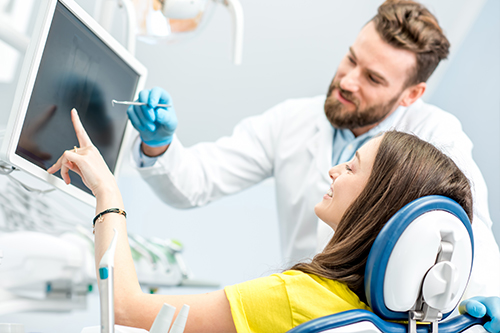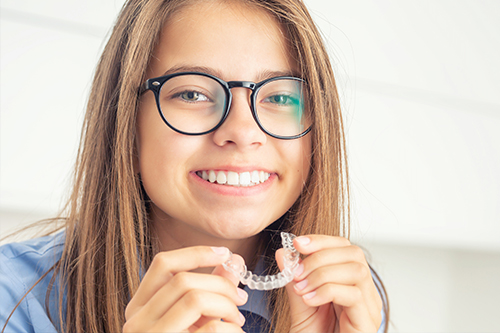
Clear aligner therapy has reimagined how adults and teens approach orthodontic care. Using a sequence of nearly invisible trays, modern aligners move teeth with careful precision while fitting into active lives. The result is a discreet, largely pain-minimized alternative to traditional brackets and wires that keeps oral hygiene simple and social confidence intact throughout treatment.
Clear aligners appeal to people who want effective tooth movement without the visual impact of metal braces. Because aligners are transparent and custom-formed to each arch, they blend into everyday life—letting patients speak, laugh, and work without frequent comments about their orthodontics. This low-profile nature makes aligners particularly popular among professionals, students, and anyone who prefers a subtler approach to smile improvement.
Another practical advantage is removability. Aligners are taken out for meals and cleaning, which reduces the risk of trapped food and helps preserve gum health during treatment. This flexibility also simplifies hygiene routines: brushing and flossing are performed normally rather than around fixed hardware, which can make a meaningful difference over the course of care.
Finally, clear aligner systems are designed to address many common alignment problems—from mild crowding and spacing to certain bite irregularities—using a planned progression of tooth movements. While not every complex case is suitable for aligners, many patients find them to be an efficient and comfortable option when managed by an experienced provider.
Contemporary aligner therapy depends on digital imaging and planning software to map a patient’s treatment from the first visit. A precise digital scan captures the current position of teeth and bite relationships, then software simulates each stage of movement. This allows clinicians to visualize the end result and refine the plan before any physical aligners are fabricated.
Digital plans bring two important benefits: predictability and customization. Because tooth movements are planned incrementally, clinicians can sequence force applications in a controlled manner to address rotations, translations, and bite adjustments. Custom attachments or refinements can be anticipated and built into the plan, improving the efficiency of each step.
Planning with digital models also improves communication. Patients can preview the proposed outcome and ask targeted questions during the consultation. Clinicians use these visualizations to set realistic expectations and to coordinate any complementary treatments—such as restorative work or enamel reshaping—that might optimize the final smile.
Treatment begins with a consultation and a comprehensive exam that includes a digital scan or impressions. From that information, a personalized plan is created and a series of custom aligners is produced. Each aligner is worn for a specified period, gently shifting teeth toward the planned position before being replaced by the next tray in the sequence.
Most aligner systems rely on consistent wear to achieve intended movement, and scheduled check-ins let the clinician monitor progress and make adjustments when needed. These visits tend to be shorter and less frequent than appointments for traditional braces, but they remain an important opportunity to verify fit, address comfort, and manage any mid-course corrections.
Throughout treatment, minor refinements are sometimes necessary to perfect alignment. These adjustments are part of a controlled process and are factored into the overall plan. With adherence to the recommended wear schedule and professional oversight, many patients experience measurable changes within weeks and see the full transformation completed over months rather than years.
Oral health and alignment go hand-in-hand. Because aligners are removable, maintaining daily hygiene is simpler than with fixed appliances, but it still requires attention. Patients should remove trays to brush and floss after eating, and rinsing or brushing before reinserting aligners helps reduce staining and bacterial buildup on both teeth and trays.
Cleaning the aligners themselves is also important. Gentle brushing and rinsing, or manufacturer-recommended cleaning solutions, keep trays clear and odor-free without compromising material integrity. Avoid hot water, which can warp plastic, and follow any aftercare instructions provided by your clinician to preserve fit and function throughout treatment.
Dietary freedom is another benefit: because aligners come out for meals, there are fewer long-term dietary restrictions compared to braces. That said, consistent wear outside of mealtimes is crucial; the best outcomes are achieved when aligners are worn as directed and when patients prioritize routine dental visits during their orthodontic journey.
At Smiles Dental at Reston Town Center, we integrate contemporary aligner techniques with a patient-centered approach to care. Our clinicians combine thorough examinations with clear explanations of treatment options, so patients understand the steps involved and can make informed choices about their smile goals. Technology plays a central role, but it’s guided by clinical experience and individualized attention.
We tailor each treatment plan to the patient’s dental health, lifestyle, and objectives, coordinating with restorative or periodontal care when needed to produce a balanced outcome. Our focus is on precise execution—using digital scans, predictable sequencing, and regular monitoring—to deliver efficient progress and the best possible result for each unique case.
Comfort and clear communication are priorities throughout care. From the initial consultation to periodic progress checks, the team emphasizes patient education—explaining how aligners work, what sensations to expect, and practical tips for everyday wear. This combination of technology, clinical skill, and supportive care helps patients move through treatment with confidence.

During your initial visit, we assess bite relationships, gum health, and tooth positions to determine whether clear aligners are a suitable option. Digital scanning captures the detail needed to create a precise, individualized plan.

A computerized preview helps you understand the proposed progression of movement and the expected outcome. Reviewing this model with your clinician ensures the plan aligns with your aesthetic and functional goals.

Each tray is manufactured to fit the specific stage of your treatment. The materials and contours are engineered to provide controlled forces while prioritizing patient comfort during daily wear.

Regular check-ins allow the team to confirm that movement is progressing as planned and to make any refinements needed. Ongoing professional oversight keeps treatment on track from beginning to end.
Explore visual resources that explain aligner features, the treatment process, and clinical considerations.
*Invisalign® is a registered trademark of Align Technology, Inc.
Whether you're exploring aligners for the first time or comparing modern treatment pathways, clear aligner therapy offers a discreet, technology-driven route to meaningful improvements in tooth alignment. If you'd like to learn more about how this option might fit your oral health and lifestyle goals, please contact our office for additional information and to schedule a consultation.

There are many options for patients who want to avoid metal braces! The most popular alternative orthodontic treatment is Invisalign®, which are clear plastic aligners designed to straighten teeth. After an examination of your teeth, your dentist will determine which option is best suited to your wants and needs.
According to the Invisalign® website, the cost for treatment is approximately the same as the cost for metal braces. A portion of this cost may be covered by your insurance. Please call us to set up a consultation and discuss potential payment plan options.
The first step is to schedule a consultation with your doctor, so they can devise a treatment plan that is best suited to your individual dental needs. Once approved, you will receive your first set of aligners. Your doctor will then regularly monitor the movement of your teeth and new aligners will be ordered according to the progress made in your treatment plan.
Invisalign® aligners are made of clear, flexible plastic. The company received a patent for this material – SmartTrack® – to be used exclusively for Invisalign treatment purposes. These aligners are FDA approved and nearly invisible!
Your doctor will give you an estimate regarding how long your Invisalign® treatment should take, which will depend on your specific needs. The average length of time for treatment is approximately 12-18 months. However, some patients may see results far sooner. Remember to wear your aligners exactly as instructed by your doctor to obtain the best results.
Your doctor will most likely recommend that you wear retainers following your Invisalign® treatment. This is a precaution that will prevent your teeth from shifting back to their original positioning. It is important to follow your doctor's instructions exactly to ensure long-lasting results.
You must wear your aligners for up to 22 hours daily. You may remove them for eating, drinking and regular oral hygiene.
No. Unlike braces, you may eat whatever you like as long as you remove the aligners before eating. Prior to placing the aligners back on, it is important to brush your teeth and the aligners after you eat.
Like any orthodontic treatment, there is a short adjustment period. The more you speak with the aligners on, the quicker you will adjust.
There will be some pressure and minor discomfort for a day or two after each initial insertion. This is a sign that your teeth are moving sequentially into their final position.
It is recommended that you remove your aligners prior to chewing gum as the gum will stick to the aligners.
We discourage smoking with aligners as the cigarette smoke will tend to discolor them.
Brushing them with toothpaste will keep them fresh and clean.
Regular office visits are every five to six weeks. This will ensure that your Invisalign treatment is progressing as planned.
All orthodontic patients are instructed to wear their retainers at night indefinitely. Sleeping with your retainers in at night will ensure a healthy bite and maintain the new position of your teeth.
Yes, if their teeth, including second molars, have grown in completely.
Invisalign® is a clear aligner system that straightens teeth using a series of custom-made, nearly invisible trays. Each tray applies gentle, controlled pressure to specific teeth to guide them into new positions. The trays are changed in sequence to produce gradual, predictable movement.
Treatment is planned with digital scans and specialized software that simulates each stage of movement. Attachments or precision cuts may be added to aligners to encourage rotation or bite correction when needed. This digital-driven approach helps clinicians anticipate challenges and refine the plan before fabrication.
Good candidates include adults and motivated teens who have mild to moderate crowding, spacing, or certain bite irregularities. Candidates should be able to follow a wear schedule and commit to removing aligners only for eating and cleaning. Very complex skeletal problems or severe tooth movements may require traditional orthodontics or combined approaches instead.
A healthy foundation of gum and tooth health is important before starting aligner therapy; untreated decay or active gum disease should be addressed first. Missing teeth, large restorations, or untreated periodontal issues can influence the treatment plan and may require coordination with restorative or periodontal care. Your clinician will evaluate these factors during the consultation and recommend the best pathway.
The initial consultation includes a comprehensive oral exam, discussion of aesthetic and functional goals, and digital imaging or impressions to record current tooth positions. The clinician assesses bite relationships, gum health, and any restorative needs that could affect treatment. This visit sets the clinical baseline and clarifies whether aligners are a suitable option.
Digital planning software is used to create a step-by-step simulation of tooth movement, allowing you to preview the expected outcome and ask informed questions. The plan can incorporate attachments, interproximal reduction, or staged restorative work when indicated. Once you approve the simulated outcome, the laboratory fabricates the aligner series for clinical delivery.
Treatment length depends on the complexity of the case and patient adherence, so timelines can vary from several months to a year or more in some situations. Many patients notice measurable changes within weeks when aligners are worn as directed and checked regularly. Your clinician will provide a personalized estimate based on the digital plan.
Factors that influence duration include the severity of misalignment, the need for attachments or bite corrections, and whether refinements are required after the initial sequence. Consistent wear and timely follow-up appointments help keep treatment on schedule and improve predictability. If additional movements are necessary, the clinician may order refinement trays to complete the result.
For optimal results, remove aligners before eating and brush and floss before reinserting them to minimize staining and bacterial buildup. Rinsing trays with cool water after removal helps keep them clear between cleanings. Avoid using hot water or abrasive cleaners that can warp or damage the material.
Clean aligners gently with a soft toothbrush and manufacturer-recommended solutions or mild soap to prevent odors and preserve clarity. When not in use, store trays in their case to protect them from damage or loss. Maintain routine dental visits for professional cleanings and exams so oral health remains stable throughout treatment.
Aligners are designed to be removed for meals and beverages other than water, which means patients can generally eat their usual diet without restrictions that accompany fixed braces. Drinking water while wearing aligners is acceptable, but colored or acidic drinks should be consumed only when trays are removed to prevent staining and material degradation. Chewing or biting with trays in place is not advised because it can distort fit and reduce effectiveness.
Because the success of treatment depends on consistent wear, patients should follow the recommended daily wear schedule and limit the time trays are out for snacks or drinks. Small lapses in wear can slow progress, so planning meals and keeping a hygiene routine helps maintain momentum. If a tray becomes warped or damaged, contact your clinician promptly to determine the appropriate next step.
Some patients experience a mild lisp or slight change in speech during the first few days as the tongue adapts to new tray contours, but this usually resolves quickly with normal use. Practicing reading aloud and speaking more frequently while wearing the aligners can speed adaptation. Most people feel comfortable speaking in social and professional settings after a short adjustment period.
Discomfort is often described as pressure when inserting a new tray rather than sharp pain, and it typically eases within a few days as teeth shift. Over-the-counter pain relievers and eating softer foods can help manage temporary soreness. If persistent or severe pain occurs, contact your clinician so they can check fit and identify any issues that need correction.
Complex cases that involve significant bite discrepancies, severe rotations, or skeletal problems may require additional orthodontic techniques, auxiliary appliances, or collaboration with specialists. Your clinician will determine whether aligners alone are appropriate or if a combined approach is necessary to achieve optimal results. Referral to an orthodontist or restorative dentist is considered when specialized care will improve the outcome.
Refinement phases are a common part of aligner treatment and are used to address minor discrepancies after the initial series is complete. New scans or impressions are taken so additional aligners can be fabricated to fine-tune tooth positions. This iterative approach is part of routine quality control and helps ensure the final occlusion meets both aesthetic and functional goals.
Predictable results start with accurate digital scans that capture tooth anatomy and occlusion for precise treatment simulation. The planning software sequences movements and allows clinicians to incorporate attachments and staging strategies that guide forces effectively. High-quality laboratory fabrication translates the digital plan into aligners that align closely with the simulated stages.
Regular clinical monitoring verifies that movement is tracking as planned and lets the team intervene early if adjustments are needed. When movements deviate from the plan, the clinician may alter force application, add attachments, or schedule refinements to correct the course. Coordination with restorative or periodontal care supports long-term stability and a balanced final result.
To get started, schedule a consultation so the clinician can evaluate your oral health, discuss goals, and take the digital records needed for planning. The initial visit includes a clinical exam and a review of treatment options so you understand the steps and expected sensations during care. This meeting is an opportunity to address questions about day-to-day wear, hygiene, and the clinical process.
Smiles Dental at Reston Town Center combines digital planning with individualized care to create predictable, comfortable aligner therapy for appropriate candidates. Contact our office to request an appointment or use the appointment form on our website to begin the process; the team will explain next steps and available scheduling options. We will coordinate any necessary restorative or periodontal care to support a healthy, lasting result.

Ready to schedule your next dental appointment or have questions about our services?
Contacting Smiles Dental at Reston Town Center is easy! Our friendly staff is available to assist you with scheduling appointments, answering inquiries about treatment options, and addressing any concerns you may have. Whether you prefer to give us a call, send us an email, or fill out our convenient online contact form, we're here to help. Don't wait to take the first step towards achieving the smile of your dreams – reach out to us today and discover the difference personalized dental care can make.